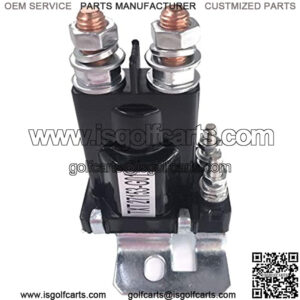Electric golf carts are convenient, efficient, and especially durable, but understand that long-lasting does not mean invincible. These carts can start to show signs of wear and may fail just like any other vehicle over time. Learn about some of the more common issues associated with electric golf carts.
1. Solenoid Wear
The solenoid is the primary electrical switch in your golf cart and is designed to ensure the current from the battery flows into the motor. When you press down on the gas pedal and hear a tapping-like sound, this is the sound of the solenoid activating. When there is a disruption in the flow of the electrical current, your cart will not operate.
A common reason for current disruption is solenoid wear. Each time the solenoid activates as you press down on the gas pedal, the solenoid compounds down onto a thin metal contact plate. Over time, the force of this pressure creates tiny electric arcs on the plates’ surface. These arcs eventually create a resistance that prevents the current from properly flowing.
You can avoid this problem by routinely inspecting the condition of the contact plate and replacing it whenever there are signs of excessive wear. The more frequently you operate your cart, the more often you will need to replace the plate.
2. Speed Controller Wear
An electric golf carts’ controller is known as the heart of the operation and closely resembles and operates much like the motherboard in a computer. So a problem with the controller will have rippling effects throughout the cart.
A common function of the speed controller is to control the speed of the golf cart. When this unit has failed, the golf cart will start up and possibly take off, without hesitation. And as you travel, no matter how firmly you press on the gas pedal, the cart will not accelerate – even if it does momentarily, you won’t be able to maintain that level of acceleration.
Problems with the sped controller occur for a variety of reasons, but most often the cause is degradation due to age or lack of use. When you replace the speed controller, since this device works so closely with the solenoid, it’s typically best to replace them at the same time, even if the solenoid is not showing signs of distress.
3. Direction Switches Wear
The direction switches, sometimes referred to as the forward and reverse switches, may also wear and fail over time. As the name suggests, the direction switches manage the cart’s ability to move backward and forwards and operate similarly to a transmission.
A key indication of a direction switch failure is when the cart powers on and operates normally, but will only move in one direction, such as backward but not forward. In this instance, this means that only one of the switches is failing. If the cart doesn’t move in either direction, both switches have failed.
Diagnosing a problem with the direction switches isn’t a complicated matter, but repairing the switch is more complex, especially if the switches are built into the speed controller. In some instances, it’s more efficient to replace the switch rather than attempt to perform the repair.
To avoid these common problems with your electric golf carts, commit to regular service, as a technician will be able to spot signs of wear long before the switches fail.
Don’t let an issue with your electric golf cart keep you from the greens. As with other mechanical issues, the sooner you tackle the problem, the sooner you can get your cart up and running efficiently again. Sierra Golf Carts & Auto is here to help you with your cart repair needs.

